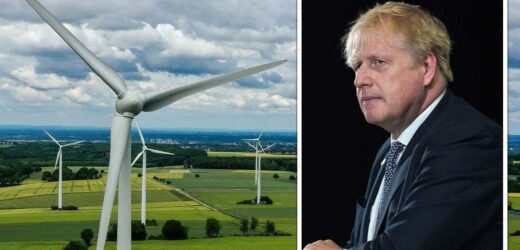BBC Breakfast: Naga grills Ofgem boss on energy prices
We use your sign-up to provide content in ways you’ve consented to and to improve our understanding of you. This may include adverts from us and 3rd parties based on our understanding. You can unsubscribe at any time. More info
THE UK’s lack of electricity storage solutions have led to the Government being forced to spend over £500million to turn off wind turbines. British households are currently reeling from the worst impacts of the global fossil fuel energy crisis, with household energy bills expected to rise to around £2,800 in October.
While the Government has touted renewable energy as the solution to ending the energy crisis, the lack of adequate storage solutions for the energy generated has meant the UK taxpayer has had to fork over millions of pounds to energy companies to simply turn off wind farms.
According to the consultancy LCP, UK taxpayers were forced to pay £507million in the last year alone to cover the costs of switching off wind turbines when it is too windy.
Due to inadequate storage infrastructure like batteries in place, wind turbines have to be turned off in order to prevent the national Grid from being overloaded.
This is an increase of more than 70 percent from 2020, according to LCP.


When these turbines are turned off, the UK is forced to switch to purchasing electricity generated from gas-fired plants.
This data highlights the complications that arise when making the necessary switch to renewable energy like solar and wind, which are intermittent sources of power.
Chris Matson of LCP told the Telegraph that growing wind power was essential for climate targets and energy security.
But he added: “And yet because investment in the infrastructure needed to support this expansion has not kept pace, wind curtailment is costing the consumer and the environment.

“Every pound spent on curtailing wind power is a pound wasted.”
Most wind projects, particularly offshore wind farms, are located far away from bustling city centres like London or Manchester.
Andy Willis, the CEO of Kona Energy previously told Express.co.uk: “A lot of these existing wind assets are subsidised which means that they will get a set price for each MWh of energy they produce.
“That’s determined by the National Grid or the Government based on the contracts, meaning regardless of what kind of day it is they get paid that same price to produce that unit of energy.
“At times when the wind farms have to be turned off, they say to the National Grid ‘look guys, we built our windfarm in a windy location. It’s your fault that you don’t have the network installed to transfer our energy from A to B’.
DON’T MISS:
Antarctica researchers stunned as ‘hidden world’ discovered under ice [ANALYSIS]
US sends Putin warning with ‘historic’ hypersonic missile test [INSIGHT]
Alien life breakthrough: NASA head CONFIRMS belief [REPORT]


“So you still have to pay them for that same subsidy price even though they’re not using that energy- that’s what building to these very high constraint costs.”
Mr Willis estimates the UK could soon spend up to a billion pounds a year paying wind farms to be turned off, and that figure is only likely to increase.
He added: “I think by 2025 or so, we’re looking at about 2.5 billion pounds a year, which is obviously a pretty phenomenal amount of money and ultimately clean energy that’s being wasted as well.”
Source: Read Full Article


